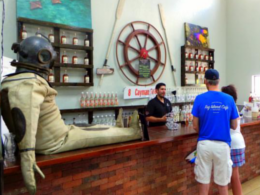The Cayman is a British Overseas Territory in the western Caribbean Sea. The 264-square-kilometre (102-square-mile) territory comprises the three islands of Grand Cayman, Cayman Brac and Little Cayman located south of Cuba, northeast of Costa Rica, north of Panama and northwest of Jamaica. The Cayman Islands are considered to be part of the geographic Western Caribbean Zone as well as the Greater Antilles. The territory is often considered a major world offshore financial haven for many wealthy individuals.
Grand Cayman, the largest island, is known for its beach resorts and varied scuba diving and snorkelling sites. Cayman Brac is popular for deep-sea fishing of tuna, marlin and barracuda. Little Cayman, the smallest island, is home to diverse wildlife, from rock iguanas to red-footed boobies.
Grand Cayman
Grand Cayman is the largest of the three Cayman Islands and the location of the territory's capital, George Town. In relation to the other two Cayman Islands, it is approximately 75 miles (121 km) southwest of Little Cayman and 90 miles (145 km) southwest of Cayman Brac. George Town, its capital, is home to the Cayman Islands National Museum, dedicated to Caymanian heritage, and the ruins of colonial-era Fort George. At the island’s centre is the Mastic Reserve and Trail, a footpath through old-growth forest, sheltering a wide variety of native plants and animals.
On the west side of Grand Cayman you will find the famous Seven Mile Beach, the crescent-shaped natural wonder with boundless capacity for relaxation. With sand stretching as far as the eye can see, Grand Cayman’s Seven Mile Beach is often rated as one of the most beautiful beaches in all the Caribbean and the least populated.
On the west side of Grand Cayman you will find the famous Seven Mile Beach, the crescent-shaped natural wonder with boundless capacity for relaxation. With sand stretching as far as the eye can see, Grand Cayman’s Seven Mile Beach is often rated as one of the most beautiful beaches in all the Caribbean - and the least populated.
Cayman Brac
Cayman Brac is an island that is part of the Cayman Islands. It lies in the Caribbean Sea about 145 km (90 mi) north-east of Grand Cayman and 8 km (5.0 mi) east of Little Cayman. It is about 19 km (12 mi) long, with an average width of 2 km (1.2 mi). Its terrain is the most prominent of the three Cayman Islands due to "The Bluff", a limestone outcrop that rises steadily along the length of the island up to 43 m (141 ft) above sea level at the eastern end. The island is named after this prominent feature, as "brac" is a Gaelic name for a bluff.
Little Cayman
It is located in the Caribbean Sea, approximately 60 miles northeast of Grand Cayman and five miles (8 km) west of Cayman Brac. Little Cayman is by far the least populous, with a permanent population of about 170. It is about 10 miles (16 km) long with an average width of 1 mile (2 km) and most of the island is undeveloped. Almost the entire island is at sea level. The highest elevation is about 40 feet (12 metres).
Little Cayman is known for its excellent scuba diving and birdwatching, unspoiled wildlife habitat and laid-back atmosphere.
Despite its small size, the island hosts a heritage festival and parade as part of Pirates Week, the annual Mardi Gras celebration of the Cayman Islands and the Sister Islands Cook-off.
Population: 58,435(2013)
Area: 101.9 mi²
Capital: George Town
Languages: English
Currency
The Cayman Islands Dollar (currency code KYD) is the currency of the Cayman Islands. It is abbreviated with the dollar sign $, or alternatively CI$ to distinguish it from other dollar-denominated currencies. It is subdivided into 100 cents. It is the 9th-highest-valued currency unit in the world, as of 22 April 2014.
Credit cards are another safe way to carry money. They also provide a convenient record of all your expenses, and they generally offer relatively good exchange rates. You can withdraw cash advances from your credit cards at banks or ATMs, but high fees make credit card cash advances a pricey way to get cash. Keep in mind that you'll pay interest from the moment of your withdrawal, even if you pay your monthly bills on time. Also, note that many banks now assess a 1{30b3c1a05441a6ec696a3ef2bf35d9a34dfa377050be22c8a6500787eb0a1c7f} to 3{30b3c1a05441a6ec696a3ef2bf35d9a34dfa377050be22c8a6500787eb0a1c7f} "transaction fee" on all charges you incur abroad (whether you're using the local currency or your native currency).
Climate
The Cayman Islands have a pleasant and warm climate all year round, with winter (November-March) averaging daytime temperatures of 24°C (72-80°F). Summer is considered to be from May through to October and sees the temperature rising to a daytime average of 28°C (80-88°F).
Education
The Cayman Islands Education Department operates state schools. Caymanian children are entitled to free primary and secondary education. Various churches and private foundations operate several private schools.
Health
There are four hospitals in the Cayman Islands. Grand Cayman is home to the private Health City Cayman Islands as well as the Chrissie Tomlinson Memorial Hospital. The public hospitals include the Cayman Islands Hospital (commonly known as the George Town Hospital); and Faith Hospital on Cayman Brac.
Many locals won't eat barracuda because it is likely that it is poisonous. Be aware of that. Other reef fish (groupers, amberjack, red snappers, eel, sea bass, and Spanish mackerel) are not likely to cause ciguatera (fish poisoning).
No natural fresh water resources; drinking water supplies are met by desalination plants and rainwater catchments.
Make sure you have sunscreen on if you plan on walking around town. It is sunny all year.
Safety
Hurricanes are possible from June through November.
Despite being more liberal than other Caribbean islanders, Caymanians are still relatively conservative. Public displays of affection (both Gay and Straight) are not usually acceptable. Acceptance of homosexual tourists is relatively new and visitors should refrain from any sort of public displays of affection. In past years Gay cruise ships have been barred from calling in the Cayman Islands, but recent policy is to remain non-discriminatory. Gay visitors can expect the same levels of hospitality and service as any other visitor, but should expect some hesitation from older Caymanians. Young Caymanians are very liberal and for the most part, won't care either way.
The Cayman Islands is a "relatively low-crime area, especially compared to other vacation destinations in the Caribbean".
Tourists should avoid certain areas (Rock Hole, Swamp, Jamaica Town/ Windsor Park, Courts Road, and Eastern Avenue) and this shouldn't be a problem as these areas are all well out of the way for most activities. In addition, George Town is virtually deserted at night as there are few centrally located restaurants, bars, or nightclubs.
Transportation
Car rentals are readily available. You must be 21 years old to rent a car. Driving is on the left hand side of the road and seatbelt use is mandatory. Visitors must get a temporary driver's license from the police station or car rental agency. This is obtained by showing a valid driving licence from their home state.
Mopeds and scooter rentals are available on Grand Cayman and Cayman Brac. Helmet use is required.
There's no ferry service from Grand Cayman to either of the sister islands, but private boat operators will shuttle you between Cayman Brac and Little Cayman.
Popular Car Rentals: Hertz, Budget, Avis, Kayak.
Top Beaches
Starfish Point
was by far my favorite beach on the island. It’s pristine sand, landscape and surroundings are right out of a magazine. STARFISH POINT is aptly named because the water is full of amazing starfish. Visitors can pick them up, but don’t take them out of the water. You can get there by car, but many people prefer to get there by boat, drop anchor and let the day drift away on the beautiful, crystal clear currents.
South Sound/Sand Cay
The Cayman Islands are not known for waves or surfing. The winds just aren’t usually in their favor for that activity, which works out well for their number one water activity, which is diving. However, when there are waves the locals wax up their boards and head for SOUTH SOUND BEACH. It’s not easy to find. You’ll need to ask a local where it is to find it, and you’ll have to catch them before they ditch work to hit the surf.
Smith Cove
This tiny little cove is hidden in the middle of a residential neighborhood, and many Caymanians bring their kids here to teach them how to swim. This spot offers nice sand, warm rocks and plenty of places to catch some rays. If it gets to hot for you, just duck under the Grape Trees that frame the beach, and take advantage of their cool canopy and bench like trunks. These are the original outdoor rooms that used to be a feature of many old Cayman houses.
Kaibo Beach
Kaibo Beach offers a casual and shady beachfront. This is where many locals go to camp during Easter weekend. On the North side of the island, this stretch of sand offers great local food and music at the KAIBO BEACH BAR and GRILL. There is a causal restaurant downstairs and fine dining upstairs. On Tuesday nights they have fun rum and BBQ parties and local music. A water taxi from Camana Bay provides some of the easiest and most direct transportation to the quaint little hideaway with many amenities.
Rum Point
Rum Point sits just about 10 miles outside of George Town. The locals always joke about what a “far drive” it is from town. Grand Cayman is only eight miles across at its widest point. An amusing FAQ sign there posts things like “Can you swim under the island?” Sunday nights a lot of boaters hang out there, and the Wreck Bar serves the best Mudslides on the island.
Seven Mile Beach
Seven Mile Beach is actually only 5.5miles however that's still miles of glorious white sandy beach and clear blue water to enjoy. It's no wonder that Seven Mile Beach has earned its reputation as one of the best beaches in the Caribbean. All of Seven Mile Beach is considered public property up to the water line so feel free to explore the many different "Public Access" beaches along SMB. Here are the most popular and designated Public Beach areas with parking and easy access
West Bay Public Beach
A popular family friendly beach in West Bay offering street parking, bathroom and changing facilities, beach cabana and plenty of shade. The beach is also adjacent to the West Bay Dock where dive companies launch from and Alfresco Restaurant for nearby dining. Located at the northern tip of West Bay Road, just before the NW Point Road turn off.
Cemetery Beach
The best snorkelling on Seven Mile Beach with plenty of shade plus parking facilities. Located at the north end of Seven Mile Beach. Look for the cemetery across from the fire station and you will find Cemetery Beach.
Accommodation
Activities
























